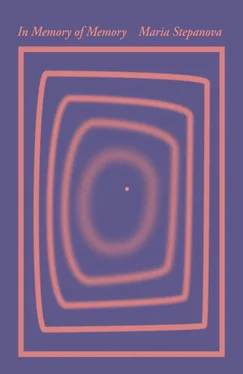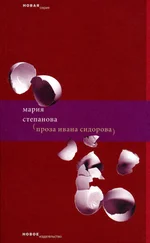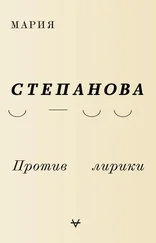I stood before the remnants of her home, doing the necessary tasks. Bemused at how little had been written down in this house of readers, I began to tease out a melody from the few words and scrappy phrases I could remember her saying: a story she had told me; endless questions about how the boy, my growing son, was doing; and anecdotes from the far-off past — country rambles in the 1930s. The woven fabric of language decomposes instantly, never again to be felt between the fingers: “I would never say ‘lovely,’ it sounds so terribly common ,” Galya admonished me once. And there were other prohibited words I can’t recall, her talk of one’s people , gossip about old friends, the neighbors, little reports from a lonely and self-consuming life.
I soon found that there was in fact much evidence of the written word in the apartment. Among the possessions she kept till her dying day, the possessions she often asked for, sometimes just to touch with her hand, were countless used notebooks and diaries. She’d kept a diary for years, not a day passed without her scribbling a note, as much a part of her routine as getting out of bed or washing. These diaries were stored in a wooden box by her headboard and there were a lot of them, two full bag loads, which I carried home to Banny Pereulok. There I sat down at once to read them, in search of stories, explanations: the oval shape of her life.
*
For the interested reader, diaries and notebooks can be placed in two categories: in the first the text is intended to be official, manifest, aimed at a readership. The notebook becomes a training ground for the outward self, and, as in the case of the nineteenth-century artist and diarist Marie Bashkirtseff, an open declaration, an unending monologue, addressed to an invisible but sympathetic ear.
Still I’m fascinated by the other sort of diary, the working tool, the sort the writer-as-craftsperson keeps close at hand, of little apparent use to the outsider. Susan Sontag, who practiced this art form for decades, said of her diary that it was “an instrument, a tool” — I’m not sure this is entirely apt. Sontag’s notebooks (and the notebooks of other writers) are not just for the storage of ideas, like nuts in squirrels’ cheeks, to be consumed later. Nor are they filled with quick outlines of events, to be recollected when needed. Notebooks are an essential daily activity for a certain type of person, loose-woven mesh on which they hang their clinging faith in reality and its continuing nature. Such texts have only one reader in mind, but this reader is utterly implicated. Break open a notebook at any point and be reminded of your own reality, because a notebook is a series of proofs that life has continuity and history, and (this is most important) that any point in your own past is still within your reach.
Sontag’s notebooks are filled with such proofs: lists of films she has seen, books she has read, words that have charmed her, the dried husks of completed endeavors — and these are largely limited to the notebooks; they almost never feed into her books or films or articles, they are neither the starting point, nor the underpinning for her public work. They are not intended as explanations for another reader (perhaps for the self, although they are scribbled down at such a pace that sometimes it’s hard to make out what is meant). Like a fridge, or as it was once called, an icehouse, a place where the fast-corrupting memory-product can be stored, a space for witness accounts and affirmations, or the material and outward signs of immaterial and elusive relations, to paraphrase Goncharov.
There is something faintly displeasing, if only in the excess of material, and I say this precisely because I am of the same disposition, and far too often my working notes seem to me to be heaped deadweight: ballast I would dearly love to be rid of, but what would be left of me then? In The Silent Woman , Janet Malcolm describes an interior that is, in some ways, the image of my own notebook (and this was a horrible realization). It is littered with newspapers, books, overflowing ashtrays, dusty Peruvian tat, unwashed dishes, empty pizza boxes, cans, flyers, books along the lines of Who’s Who , attempting to pass as real knowledge, and other objects passing as nothing at all, because they lost all resemblance to anything years ago. For Malcolm this living space is Borges’s Aleph, a “monstrous allegory of truth,” a gristly mass of crude fact and versions that never attained the clean order of history.
*
My Aunt Galya’s diaries were completely peculiar, and their strangely woven texture, which reminded me above all of chain-link fencing, intrigued me more and more as I read them.
At any of the big art exhibitions I visited as a child, there were always a few viewers who stood out to me, and they were usually, and inexplicably, women. These women went from one picture to another, bending over the captions and making notes on pieces of paper or in exercise books. It dawned on me at some point that they were simply copying down the names of all the pictures, making for themselves a sort of homemade catalog — a shadow copy of what they’d seen. And I wondered why they were doing it, and hadn’t yet realized that a list creates the illusion of possession: the exhibition would pass and dissolve in the air, but the piece of paper held the order of sculptures and pictures, as freshly as when they first saw them, long after the actual images had faded.
Galya’s diaries were just such lists, but of daily occurrences, recorded with astonishing exactness, and with astonishing opacity. The diaries documented the time she got up and when she went to sleep, the television programs she’d watched, the number of phone conversations she’d had, who they’d been with, what she’d eaten, whatever else she’d done. There was a minute and virtuosic avoidance of content — how she’d actually filled her hours. It might say “read,” for example, but with no mention of what the reading material had been or what it had meant to her — in fact everything in her long and exhaustively documented life was the same. Nothing indicated what this life had been for, there was nothing about herself, nothing about other people, only the fastidious details, the fixing of the passing of time with the exactitude of a medieval chronicler.
I kept thinking that surely life would rear its head, if only once, and reveal itself in all its color. Hadn’t she spent her life reading — wouldn’t that alone have provoked intense reflection? There were also the constant slights and grievances that my aunt clung to, and only reluctantly relinquished. Surely something of this would be preserved and laid out in a final furious paragraph, in which Galya would tell the world, and us, its representatives, what she thought of us — the unexpurgated truth.
But there was nothing of the sort in the diaries. There were hints and semitones of meaning, folds in the weave that denoted emotion, “hurray” written in the margin against the note of a phone call with my father or with me, a few opaquely bitter comments on her parents’ anniversaries. And that was it. It was as if the main task of each and every note, each completed year’s diary, was a faithful witnessing of the exterior, and a concealment of the authentic and interior. Show everything. Hide everything. Preserve it forever.
What was it she held to be of such value in these diaries? Why did she keep them by her bedside until her dying day, frightened they would be lost, often asking for them to be moved closer to her? Perhaps the written text as it stood — and it was the tale of a life of loneliness and the imperceptible slide toward nonexistence — still had the force of an indictment. The world needed to read all this, to realize just how shoddily we had dealt with her.
Читать дальше











